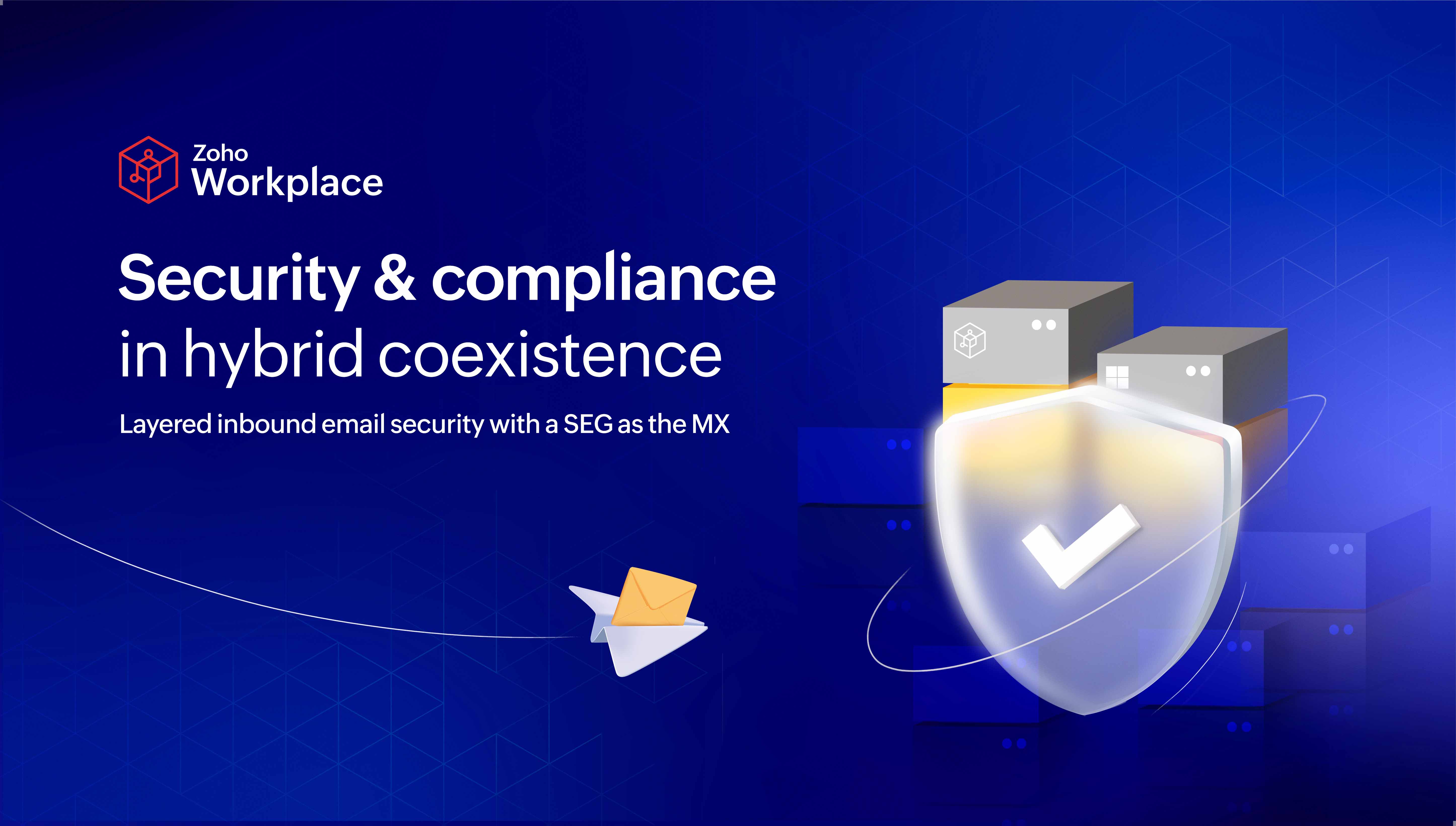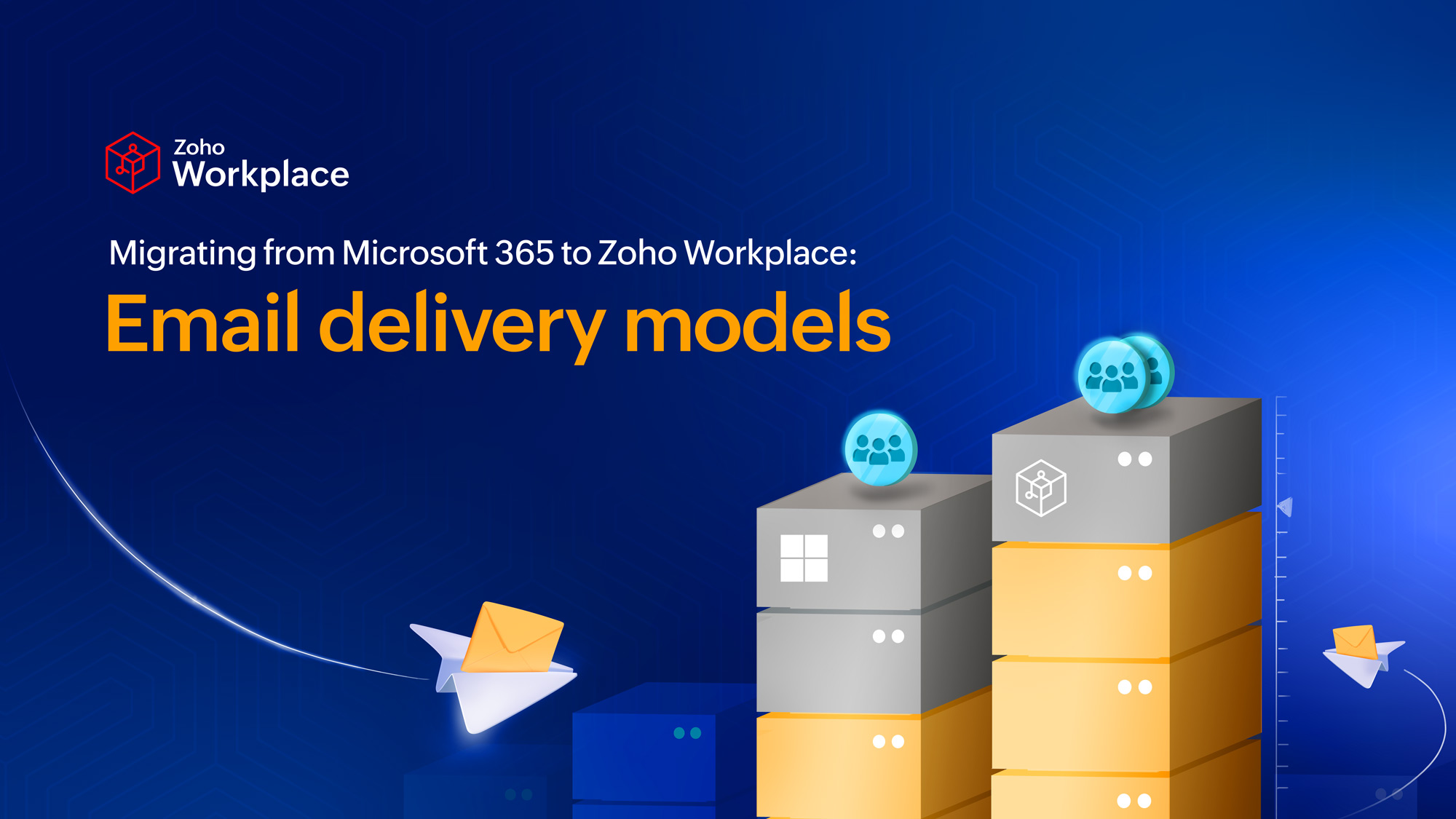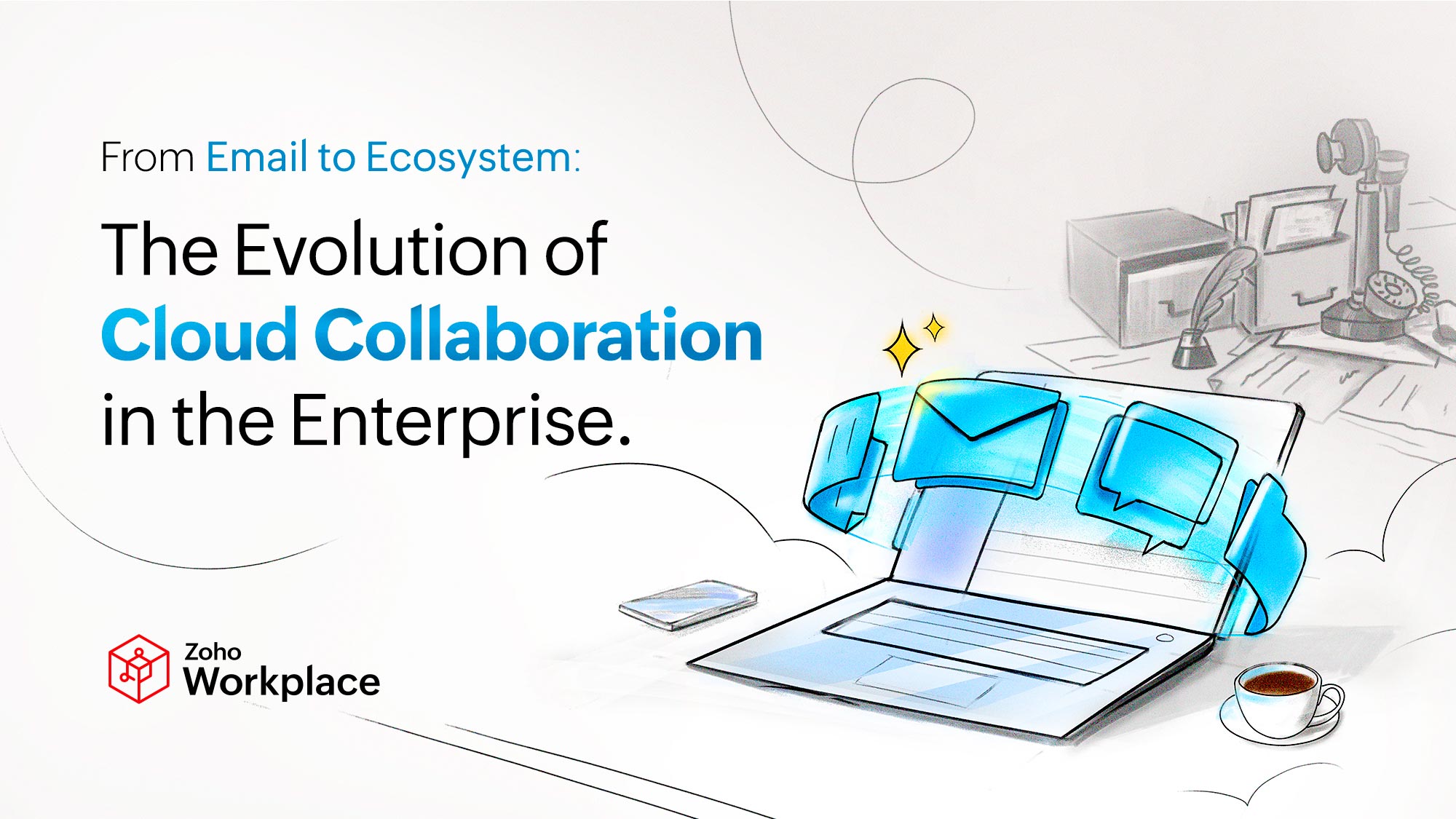- HOME
- All Products
- 4 kinds of security to look for in an email provider
4 kinds of security to look for in an email provider
- Published : July 21, 2023
- Last Updated : September 16, 2025
- 848 Views
- 8 Min Read
It's an irrefutable fact that email remains the top mode of communication in organizations. According to research by Statista, approximately 333 billion emails are sent and received each day, and this number is projected to grow in the coming years.
However, this massive number makes the email platform a juicy target for cyberattacks. Your email provider must ensure that your emails, data, and accounts are protected with top-notch security practices.

Below are four kinds of security every email provider must offer to make all email communications secure.
1. Data security
Protection from advanced threats
As technology advances rapidly, so do cyber threats such as malware and ransomware. Your email client must possess predictive security mechanisms to identify threats in real time and eliminate them to safeguard personally identifiable information (PII) and confidential organizational data from hackers. Some of the devastating yet frequent cyberattacks include phishing, brand forgery, and malware.
Are you phished?
Phishing attacks, which typically occur via emails, contain messages from a seemingly trustworthy source—a colleague, your boss, or your CEO—in an attempt to get their hands on critical organization data. According to Security Magazine, more than 255 million phishing attacks occurred in 2022, a whopping 61% increase in attack rate compared to 2021.
Business email compromise, VIP fraud, and brand impersonation are all different phishing attack types that threaten to infiltrate your organization’s database, often leading to severe financial losses.
Your email client's threat detection mechanism must detect and alert you against suspicious sign-ins, forged domains, and fraudulent display names. In addition, it should cross-check the sender against multiple sources to determine their authenticity and warn you in event of any impersonation.
Malware danger
Malware, once injected into your system, enables hackers to steal your passwords and files—in short, hijacking your organization's network. This malware can be embedded into any object—web bugs, Java scripts, HTML-based tags, links, email attachments, and others. One study showed that 51% of targeted attacks contain links to malware.
The email client must monitor your traffic and safeguard your organization against malware. It should contain a built-in antivirus attachment scanner to identify and block files with malicious programs.
Email policies to secure your data
With email policies, you take control of the emails sent and received in your organization and ensure your employees’ email communications are aligned with the organization's security measures. An email security policy enhances your defenses and protects you against legal liabilities.
While each organization has its own custom policies, some criteria are considered standard for most organizations. The email client you use must be able to restrict user permissions, even at a micro level if necessary. Here are some of the key areas an email policy should focus on:
- A well-crafted email policy monitors all inbound and outbound emails to reduce the risk of espionage.
- A refined email policy will be flexible enough to let you devise a custom policy, set conditions, apply it to a user group you want, and control their access to your data.
- A strong email policy implements firewalls and restrictions against certain domains and email addresses, greatly narrowing the entry points through which cyberattacks might get in.
A meticulous email policy clearly asserts to employees that emails are the organization's property and communicates the consequences of breaching any enforced policy.
No spamming, please
It's not a pretty sight to see a ton of spam emails in your inbox. Let's face it, it's taxing and annoying to sort through them to see if there’s an important email in their midst.
According to Statista, 50% of the emails sent worldwide are considered spam. Though only 2.5% of spam emails pose threats, the dangers involve identity theft, disastrous data and financial loss, and compromised security.
Therefore, your email client should have a sophisticated spam filter that’s able to classify unsolicited advertisements and unverified emails as spam and warn users when any malicious emails arrive. In addition, the spam filter should be updated constantly with new spam fingerprints, such as IP reputation and sender-based alerts to keep spam emails at bay. A competent spam filter should:
- Employ a user-centric, customizable approach so you can analyze organization-wide emails at your preferred level. Whether you want to analyze the sender or the subject, conduct background checks, or do a system-level spam check on emails, the spam filter must be flexible enough to let you have control.
- Validate emails against sender policy framework (SPF), domain keys identified mail (DKIM), domain-based message authentication, reporting, and conformance (DMARC), and domain name system blacklists (DNSBL) checks to identify servers and authenticated domains and only let emails from verified sources get through. Emails that fail any of these verifications should be rejected or quarantined.
- Smart enough to detect spam patterns in emails—a repeated name, phrase, or expression—and warn users when such patterns are identified in emails.
Be adept to recognize emails in different languages and from other countries of origin and take delivery action on those emails configured by you.
DMARC to protect your brand
According to Deloitte, 91% of network attacks of organizations involve email. Spammers often forge or fake senders’ addresses in the emails, and make it appear as though they come from your domain. Domain owners can combat cyberattacks like business email compromise, phishing, and spoofing by putting DMARC in place.
DMARC is an email authentication protocol with a reporting system that aligns with the widely deployed SPF and DKIM protocols and protects your domain from fraudulent email, making secure email communication possible.
A DMARC policy enables a sender to specify that their emails are protected by SPF and/or DKIM and informs the recipients of what to do in the event that both SPF and DKIM checks are unsuccessful, such as quarantining or rejecting the message. DMARC reduces or eliminates the end recipient's exposure to such spoofed emails using the domain by assisting the receiver in handling the failed messages more effectively.
Your email client must include DMARC protection as a standard to protect your domain against fraudulent emails and identities. A DMARC policy helps in the following ways:
- It ensures the legitimacy of the emails received on its servers.
- It helps prevent domain spoofing, which preserves your reputation, resulting in more emails from your brand reaching recipients' inboxes.
- It drastically reduces the number of spam messages and flags potential phishing emails, saving your business from damage.
You can learn how to authenticate any broken or unverified sources and secure your domain from the report.
2. Email security
Email encryption to protect your emails
To make emails secure, encrypting them is a must. Encryption provides the first line of defense. Emails without encryption can be easily intercepted by hackers who can hijack your email account, leading to devastating financial and data loss. Email encryption scrambles the contents of your email, making it illegible for those who don't have access to the encryption key. The email can be read only by someone with the correct encryption key.
Therefore, your email client must have the capability to encrypt your emails with industry-recognized encryption protocols. An email client placing security and privacy of users at its core must offer:
- Encryption at rest
- Encryption in transit
- End-to-end encryption
Encryption at rest
Emails are stored on the email client's servers in encrypted format where your data is split into fragments and each fragment is then further encrypted.
Encryption in transit
Encryption is applied to all email traffic between your device and the server. If, for example, you have post office protocol (POP)/internet message access protocol (IMAP)/simple mail transfer protocol (SMTP) clients configured to your email client's servers, your data won't be read or tampered with during transit.
End-to-end encryption
End-to-end encryption (E2EE) ensures your email is encrypted all the way from your device to the recipient's device and offers complete privacy. No one, not even your email provider, will be able to decrypt the data in those emails. There are two standard end-to-end encryption protocols:
- Secure/multipurpose internet mail extension (S/MIME)
- Pretty good privacy (PGP)
S/MIME encryption
The Secure/Multipurpose Internet Mail Extension (S/MIME) encryption protocol encrypts the email content sent between two S/MIME enabled users, rendering it unreadable to all parties other than the intended recipient. Emails sent between two S/MIME-enabled users are digitally signed to prevent spoofing.
PGP encryption
To provide privacy and authentication of your emails, the Pretty Good Privacy (PGP) encryption protocol combines digital signatures, secret keys, and public key encryption.
3. Infrastructure security
Aside from the email application securing your data and preventing cyberattacks, your email service provider must ensure your infrastructure—hardware, software, network, and data—is protected from physical damage. These damages can be caused by personnel or by natural calamities such as fire, flood, or earthquake, which will severely impede your organization's operations and result in a huge financial loss.
Therefore, the email provider must set up mechanisms to ensure that their data centers and hardware remain unaffected in the face of these events. The email infrastructure security framework must be vigilant in the scenarios discussed below.
Data centers
Access to data centers should be restricted to a small group of authorized personnel. Any additional access should only be permitted with the consent of the relevant managers. Additional two-factor authentication and biometric authentication must be mandated to enter the premises. In case of an incident, access logs, activity records, and camera footage needs to be accessible.
To achieve resilience and guarantee business continuity, it’s also necessary to put physical measures in place, such as power backup, temperature control systems, and fire-prevention systems.
Network security
To secure the network, firewalls must be installed to protect the network from unauthorized access and undesirable traffic. Authorized personnel should check every day to see if there are any changes as well as review the network periodically to determine whether improvements can be made. All crucial parameters must be continuously monitored and alerts should be triggered in any instance of abnormal or suspicious activity in the production environment.
Distributed denial of service prevention
Your email provider must be equipped with top industry-standard technologies to prevent distributed denial of service (DDoS) attacks on their servers. The technology must be capable of preventing any disruptions caused by bad traffic and keep websites, applications, and APIs running.
4. Account security
Securing your users' accounts is a crucial step to data security because it prevents unauthorized access to your organizational data. Your email client must have multiple lines of defense to protect your users' account credentials so that they’re not open to any attacks.
Multi-factor authentication
By requiring an additional verification method besides the password that the user must input, multi-factor authentication (MFA) adds an extra layer of security. This can significantly lower the possibility of unauthorized access in the event that a user's password is stolen.
Single sign-on
Single sign-on (SSO) lets users access multiple services using the same sign-in page and authentication credentials. There is only but an almost non-existent chance that the credentials will be compromised because they’re all kept in one extremely secure location. By eliminating the need to enter unique passwords multiple times, the workflow across applications is safer and more convenient.
Unusual activity report
Your email client must constantly monitor the account for any unusual activity. In the event of any suspicious activity—including a login from a new location—the user and the administrators should be promptly notified.
Security certificates
To present the look of a trustworthy and secure email provider, the provider should ensure that the email client adheres to widely recognized international standards for their applications, technology, processes, systems, and people. Any email provider committed to their users' privacy and security must comply with the following notable global industry standards:
- ISO/IEC 27001
- ISO/IEC 27701
- ISO/IEC 27017
- ISO/IEC 27018
- SOC 2 type 2
- SOC 3
- GDPR
- CCPA
- HIPAA
A secure cloud environment
Security and privacy of customers' data should always be the foremost priority of any email provider. Aside from strong security, read this blog to know what other features to look for in an email client before choosing one for your business.
Given the massive increase in cyberattacks, your email provider must constantly update themselves on new techniques and technologies to safeguard your data. Your email provider must offer a top-notch, secure cloud environment where you should never need to look over your shoulder, concerned about how secure your data is.
 Prashanth
PrashanthPrashanth is a Senior Product Marketer in the Zoho Workplace team who focuses more on Workplace productivity and how teams can work better. He loves bringing a creative element to his work. He enjoys traveling, writing, reading, and playing badminton.


